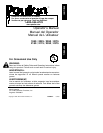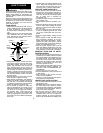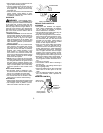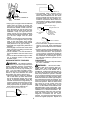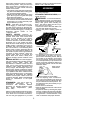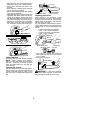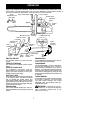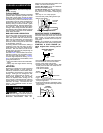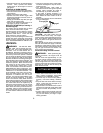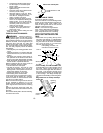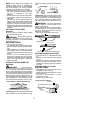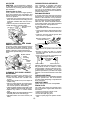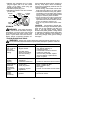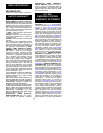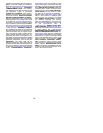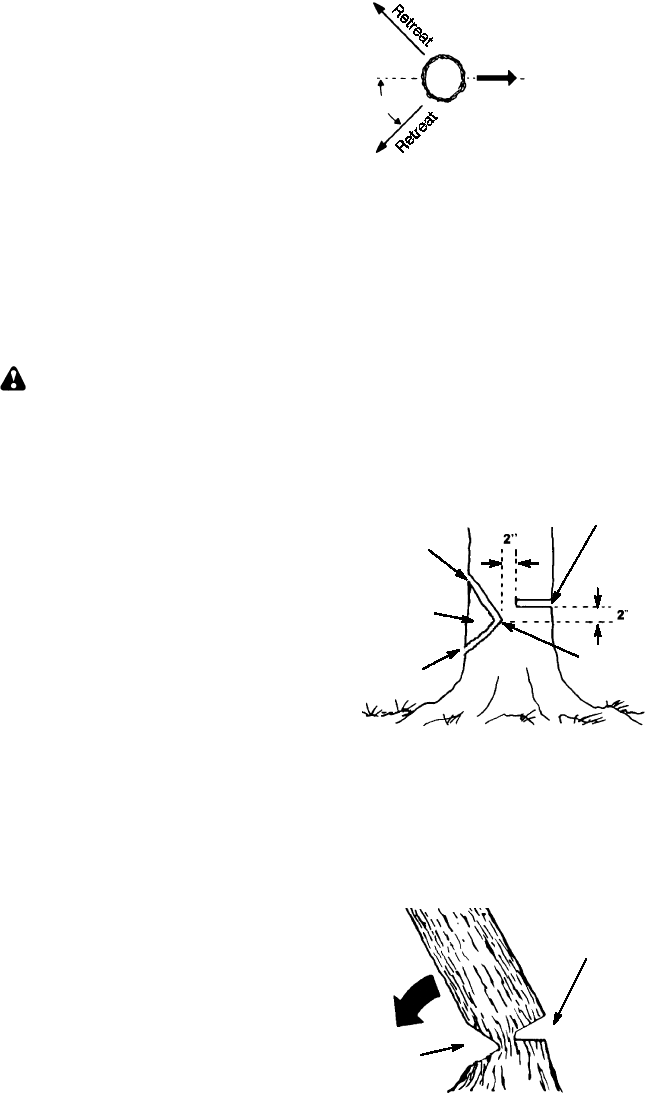
10
S
Squeeze the t hrottle trigger and al-
low the engine to reach full speed
before cutting.
S
Begin cutting with the saw frame
against the log.
S
Keep the engine at full speed the en-
tire time you are cutting.
S
Allow the chain to cut for you. Exert
only light downward pressure. If you
force the cut, damage to the bar,
chain, or engine can result.
S
Release the throttle trigger as soon
as t he cut is completed, allowing the
engine to idle. If you run the saw at
full throttle without a cutting load, un-
necessary wear c an occur to the
chain, bar, and engine.
S
To avoid losing control when cut is
complete, do not put pressure on
saw at end of cut.
S
Stop the engine before setting the saw
down after cutting.
TREE FELLING TECHNIQUES
WARNING:
Check for broken or
dead branches which can fall while cutting
causing serious injury. Donot cut nearbuild-
ings or electrical wires ifyou donot know the
direction of tree fall, norcutat night since you
will not be ale to see well, nor during bad
weather such asrain, snow, o rstrong winds,
etc. If the tree makes contact with any utility
line, the utility company should be notified
immediately.
S
Carefully planyoursawing operation inad-
vance.
S
Cleartheworkarea. You needa cleararea
all around the tree so youcan have secure
footing.
S
The chain saw operator should keep on
the uphill side of the terrain as the tree is
likely toroll orslide downhill after itisfelled.
S
Study the nat ur al condi tions t hat can cause
the tr ee t o fall in a particular direction.
Natural conditions that can cause a tree to
fall in a particular direction include:
S
The wind direction and speed.
S
The lean of the tree. The lean of a tree
might not be apparent due to uneven or
sloping terrain. Usea plumb or level to de-
termine the direction of tree lean.
S
Weight and branches on one side.
S
Surrounding trees and obstacles.
Look for dec ay and rot. If the trunk isrotted,
it can snap and fall toward the operator.
Check for broken or dead branches which
can fall on you while cutting.
Make sure there is enough room for the tree
to fall. Maintain a distance of
2-1/2
tree
lengths from the nearest person or other ob-
jects. Engine noise can drown out awarning
call.
Remove dirt, stones, loose bark, nails, sta-
ples, and wire fromthe treewhere cuts areto
be m ade.
Plan a clear retreat path to the rear and di ag-
onal to the line of fall.
Direction of Fall
45
_
Plan a clear retreat path
FELLING LARGE TREES
(6 inches in diameter or larger)
The notch method is used to fell l arge trees.
Anotch is cuton the side ofthe tree inthe de-
sired direction of fall. After a felling cut is
made on the opposite side o f tree, the tree
will tend to fall into the notch.
NOTE:
If the tree has large buttress
roots, remove them before making the
notch. If using saw to remove buttress
roots, keep saw chain from c ontacting
ground to prevent dulling of the chain.
NOTCH CUT AND FELLING THE
TREE
S
Make notch cut by cutting the top of the
notch first. Cut through
1/3
of the diameter
ofthe tree. Nextcomplete thenotch bycut-
ting the bottom of the notch. See illustra-
tion. Once the notch is cut remove the
notch of wood f rom the tree.
Notch
First cut
Second cut
Final (felling) cut here. 2 in-
ches above center of notch.
Hinge
S
After r emoving the wood from the notch,
make thefelling cuton the opposite side of
the notch. This is done by making a cut
about two inches higher than the center of
the notch. This will leave enough uncut
woodbetween thefelling cut and the notch
to form a hinge. This hinge will help pre-
ventthetreefromfalling inthe wrongdirec-
tion.
Opening
of felling
cut
Closing of
notch
Hinge holds tree on stump and helps
control fall



